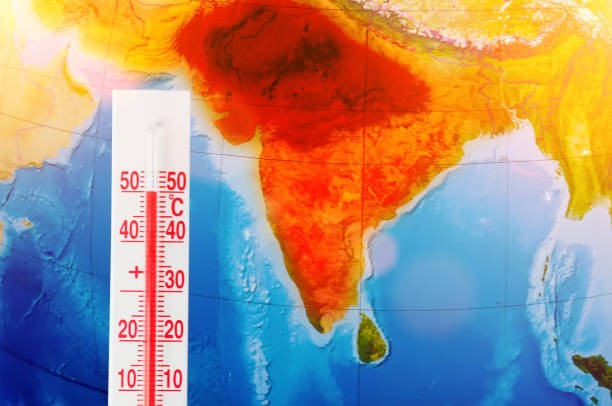
15-Jun-2025 02:00 PM
Understanding Heat Waves in India
Category: Prelims – Current Affairs & Events
What Are Heat Waves?
Heat waves are extended periods of abnormally high temperatures—much hotter than what is typically expected for a particular region during that time of year. These temperature surges aren’t uniform across all areas, as each place has its own normal temperature range based on its historical climate data.
For example, what’s considered a heat wave in the northern plains of India may not be the same in hilly regions.
When Is It Officially a Heat Wave?
The India Meteorological Department (IMD) defines a heat wave based on two criteria:
🔸 Based on Departure from Normal Temperature:
Heat Wave: When the temperature is 4.5°C to 6.4°C above normal.
Severe Heat Wave: When the temperature is more than 6.4°C above normal.
🔸 Based on Actual Maximum Temperature:
Heat Wave: When the temperature touches or crosses 45°C in the plains.
Severe Heat Wave: When it reaches or exceeds 47°C.
In hilly regions, if the maximum temperature hits 30°C or more, it's also considered a heat wave.
When and Where Do Heat Waves Strike in India?
Heat waves usually begin in March and can last until June, occasionally stretching into July if summer lingers.
The core heatwave zone in India includes:
North India: Delhi, Punjab, Haryana, Uttar Pradesh
Central India: Madhya Pradesh, Chhattisgarh, Vidarbha (Maharashtra)
East India: Odisha, Gangetic West Bengal
South India: Coastal Andhra Pradesh, Telangana
West India: Rajasthan
Currently, the IMD has issued orange and yellow alerts for heat waves in several parts of Delhi and Uttar Pradesh due to rising temperatures.
Why Should We Be Concerned About Heat Waves?
The growing frequency and intensity of heat waves are becoming a serious concern in India. They're not just uncomfortable—they're dangerous. Here's why:
🌱 Impact on agriculture: Crops can wilt under the extreme heat, affecting yields.
🧍♂️ Health hazards: Dehydration, heat strokes, and even fatalities are common.
🔌 Stress on infrastructure: Power demand surges, causing blackouts and water shortages.
What Causes Heat Waves?
Several factors contribute to the formation of heat waves:
High-pressure systems trap warm air close to the ground.
Climate change leads to warmer average temperatures globally.
Weather patterns like El Niño can intensify heat over the Indian subcontinent.
In 2025, forecasts suggest temperatures may soar past 44°C in many regions of India.
FAQs: Your Questions Answered
Q1. What exactly is a heat wave?
Ans. A prolonged period of unusually high temperatures.
Q2. Why are heat waves getting more attention now?
Ans. Due to their increasing frequency and the severe effects on health and daily life.
Q3. What are the main causes?
Ans. High pressure, climate change, and altered weather systems.
Q4. How hot could it get this year?
Ans. IMD expects temperatures over 44°C in many areas during peak summer.
Quick Quiz:
1. What is the minimum temperature for declaring a heat wave in the plains?
A. 35°C
B. 40°C
C. 45°C
D. 50°C
✔️ Answer: C. 45°C
2. What temperature marks a severe heat wave based on actual readings?
A. ≥44°C
B. ≥45°C
C. ≥46°C
D. ≥47°C
✔️ Answer: D. ≥47°C
3. During which months are heat waves most common in India?
A. January to March
B. March to June
C. June to August
D. September to November
✔️ Answer: B. March to June
4. Which of the following is NOT a core heatwave zone?
A. Rajasthan
B. Kerala
C. Odisha
D. Vidarbha
✔️ Answer: B. Kerala